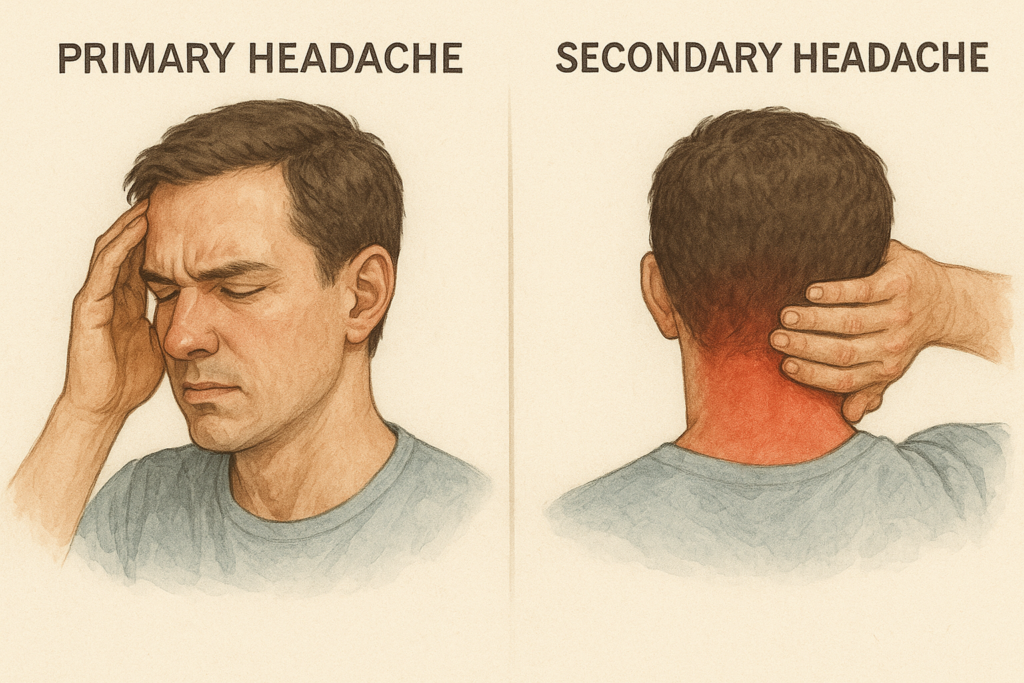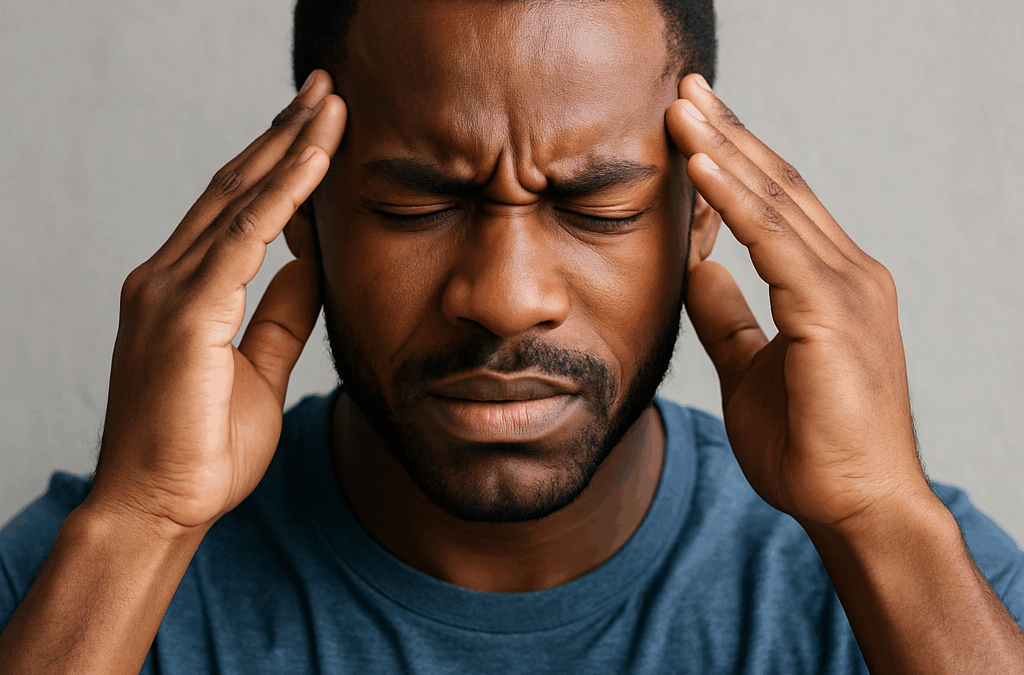From throbbing migraines to debilitating tension headaches, understanding the various types of headaches, their causes, and treatments is key to finding relief and reclaiming your life.
Key Takeaways:
- A headache is a pain around the head, face, or neck and can range from mild to severe.
- There are several types of headaches, including primary and secondary types. Each has different causes and treatment options.
- Triggers include stress, dehydration, poor sleep, and medical conditions like high blood pressure or meningitis.
- Most headaches are harmless, but some may be signs of life-threatening conditions like stroke or brain hemorrhage
- Treatment and prevention depend on the type of headache and its underlying cause.
- Seek medical attention for sudden, severe headaches or if headaches interfere with daily life.
Understanding the Different Types of Headaches and Treatment
Headaches are among the most common health complaints worldwide, affecting millions of people every day.
From a dull ache that creeps across your temples to a sudden, stabbing pain behind your eyes, headaches come in various forms and knowing the type you’re dealing with is the first step toward effective relief.
The World Health Organization estimates that nearly half of the global adult population has had a headache at least once within the last year.
While many headaches are benign and temporary, others can be debilitating and may even signal serious medical conditions. This makes it crucial to understand the types of headaches and treatment options available.
In this comprehensive guide, we’ll break down the different types of headaches, what causes them, how to treat them, and most importantly, how to prevent them from disrupting your life.
We’ll also share expert insights from Dr. Naomi-Jean-Baptiste, a U.S.-based emergency physician and founder of Hope4Med.
Now, Let’s begin!!
What Is a Headache?
Before exploring the types of headaches, it’s important to clarify what a headache actually is.
Simply put, a headache is pain or discomfort in the head, scalp, or neck area. It can feel like throbbing, pressure, sharp stabbing, or a dull ache. Headaches vary in duration and intensity….lasting from a few minutes to several days.
To help us better understand, Dr. Naomi Jean-Baptiste explains,
“The brain cannot feel pain, and the pain that people with primary headaches experience is due to inflammation of the nerves and muscles around the head and neck.”
With this foundational understanding, let’s look at what triggers these pains.
Causes of Headaches: What Triggers the Pain?
Headaches do not just happen randomly; many factors can trigger their onset. Common culprits include:
- Stress and anxiety
- Dehydration
- Lack of sleep
- Skipping meals
- Caffeine withdrawal
- Exposure to loud noises
- Hormonal fluctuations
- Alcohol and drug use
- Changes in weather or altitude
Moreover, Dr. Jean-Baptiste highlights,
“Some of these conditions include viral infections such as influenza and COVID, bacterial infections like meningitis, and medical conditions like ruptured aneurysm (brain bleeding).”
In addition to these, more serious health issues can also cause headaches. These include:
- High blood pressure
- Brain tumors
- Meningitis
- Stroke
- Subarachnoid hemorrhage
Such conditions typically lead to secondary headaches, which we’ll discuss further down. But first, understanding the sensation of headaches helps us identify them better.
What Does a Headache Feels Like?

Recognizing the sensation can help you better describe your symptoms to a doctor. Headaches manifest in various ways, such as:
- Aching pain: Mild to moderate, persistent pain often on both sides of the head.
- Pulsating or pounding pain: Often linked to migraines, it feels like your heartbeat is in your head.
- Pressure or tightness: Like a band tightening around your skull….common in tension headaches.
- Sensitivity to light and sound: Common migraine symptoms, also called photophobia and phonophobia.
- Nausea or vomiting
- Neck or shoulder stiffness
Now that we know how headaches feel, let’s explore their types in greater detail.
Main Types of Headaches and Treatment Options

Headaches generally fall into two broad categories: Primary headaches and Secondary headaches. Each category has distinct causes, symptoms, and treatment strategies.
Primary Headaches
Primary headaches are those not caused by another medical condition; instead, they are the medical condition themselves. Let’s explore the common types in detail.
Migraine Headaches
Migraines are a neurological disorder affecting over 1 billion people worldwide, often characterized by severe and recurring headaches.
Symptoms include:
- Intense, throbbing or pulsing pain, usually localized on one side of the head
- Nausea and vomiting
- Heightened sensitivity to light (photophobia), sound (phonophobia), and sometimes smell
- Visual disturbances known as aura in some cases, including flashing lights or blind spots
Types of Migraines:
- Migraine with aura: Characterized by sensory disturbances before the headache
- Migraine without aura: No sensory warning signs
- Chronic migraine: Occurs 15 or more days per month
Stages of a Migraine Attack:
- Prodrome: Early symptoms like mood swings, food cravings, and fatigue appear hours or days before the headache.
- Aura: Visual or sensory symptoms emerge, lasting from minutes to an hour.
- Attack: The headache phase, typically lasting from 4 to 72 hours.
- Postdrome: Residual symptoms such as tiredness and confusion.
Treatment Options:
- Acute relief with triptans (e.g., sumatriptan) and NSAIDs like ibuprofen
- Anti-nausea medications to control vomiting
- Preventive therapies including beta-blockers, anticonvulsants, and newer CGRP inhibitors
Note: These medications should only be taken under the guidance of a healthcare professional.
Tension Headaches
Tension headaches, also called stress headaches, are the most frequent type affecting adults worldwide.
Symptoms include:
- Steady, dull, aching pain, often felt as a tight band around the head or forehead
- Tenderness in the scalp, neck, and shoulder muscles
- Mild to moderate intensity, usually bilateral
Treatment Options:
- Over-the-counter pain relievers such as aspirin, acetaminophen, or ibuprofen
- Relaxation techniques including meditation and massage
- Applying warm or cold compresses to ease muscle tightness
Cluster Headaches
Although relatively rare, cluster headaches are among the most painful forms of headache, sometimes called “suicide headaches” due to their intensity.
Symptoms include:
- Severe, piercing pain typically focused around or behind one eye
- Redness and watering of the eye
- Nasal congestion or runny nose on the affected side
- Restlessness or agitation during attacks
Cluster headache episodes usually occur in cyclical patterns, or “clusters,” lasting weeks or months, followed by remission periods.
Treatment Options:
- Immediate relief through 100% oxygen inhalation therapy
- Triptans administered as injections or nasal sprays
- Preventive medications such as verapamil to reduce attack frequency
Secondary Headaches
Secondary headaches occur as a symptom of another underlying medical condition, which means identifying and treating that condition is crucial.
Dr. Jean-Baptiste emphasizes:
“Some medical conditions that could cause secondary headaches include high blood pressure, brain tumors, inflammation, and infections.”
Let’s look at key examples.
Medication Overuse Headache
Commonly known as rebound headaches, these occur when painkillers such as acetaminophen or ibuprofen are used excessively, often more than 15 days per month.
Symptoms include:
- Daily or near-daily headaches
- Worsening headache pain despite medication use
Treatment: The best approach is to gradually reduce and stop the overused medication under medical supervision.
Thunderclap Headache
This type is characterized by an abrupt onset of severe headache pain, reaching maximum intensity within seconds to a minute. It is a medical emergency as it may signal life-threatening issues like brain hemorrhage or stroke.
Symptoms include:
- Sudden, explosive headache often described as the “worst headache of life”
- Accompanying symptoms may include vomiting, visual loss, or altered consciousness
Immediate medical evaluation is essential.
Post-Traumatic Headache
These headaches develop after head trauma or concussion and can last for weeks or months.
Symptoms include:
- Persistent headache similar to tension or migraine headaches
- Cognitive difficulties and mood changes
Treatment: Includes pain management, cognitive therapy, and rest.
How to Get Rid of the different types of Headaches
The treatment needed depends largely on the headache type and severity. Common approaches include:
- Over-the-counter (OTC) painkillers: Paracetamol, ibuprofen, and aspirin can alleviate mild to moderate headaches.
- Prescription medications: Such as triptans for migraines or preventive drugs like beta-blockers.
- Natural remedies: Magnesium supplements, peppermint oil, yoga, and acupuncture have shown some benefits.
- Lifestyle changes: Staying hydrated, eating regular meals, and managing stress.
How to Prevent Headaches: Expert Tips That Work
Prevention is always better than cure. According to Dr. Jean,“Living a healthy lifestyle is key to preventing headaches.”
Her recommended strategies include:
- Don’t skip meals to maintain stable blood sugar levels
- Drink plenty of water to avoid dehydration
- Maintain a regular sleep schedule, ideally going to bed between 7 and 9 pm
- Reduce or eliminate caffeine intake, as it can trigger or worsen headaches
- Exercise regularly to improve blood flow and reduce stress
- De-stress often through calming activities like listening to music, walking, or traveling
When to See a Doctor
It’s important to recognize when a headache needs urgent medical attention. Dr. Jean-Baptiste advises seeing a doctor if you experience:
- Sudden, severe headaches that peak quickly
- Increasing headache intensity over a short time
- Changes in behavior, speech, vision, or movement
- Convulsions or seizures
- Stiff neck, fever, or rash
- Headache after head trauma
Such symptoms could indicate life-threatening conditions like meningitis, stroke, or brain bleeding.
Taking Control of the difference Types of Headaches with myMedicines
Headaches can range from minor annoyances to signs of serious illness. Understanding the types of headaches and treatment options empowers you to manage and prevent them effectively. Remember, lifestyle changes and timely medication can drastically reduce headache frequency and severity.
For personalized medication management and convenient access to quality medicines, consider using myMedicines, a trusted online pharmacy that delivers authentic medications right near you. With expert advice and a wide selection of headache treatments, myMedicines will help you stay ahead of your headache triggers and with tele consultation to help you maintain your health without stress.
Take control of your headaches today …..Get armed with knowledge, expert advices, and reliable medication support from myMedicines.

 We use cookies to ensure that we give you the best experience on our website. If you continue to use this site we will assume that you are happy with it.
We use cookies to ensure that we give you the best experience on our website. If you continue to use this site we will assume that you are happy with it.